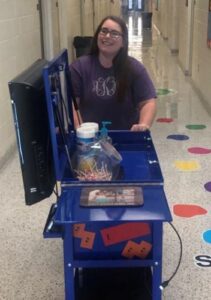by James A. Bacon
In Washington County, down by the border with Tennessee, Emory & Henry College students are helping to fill gaps in the ranks of local school teachers by volunteering as substitutes. Writes the Bristol Herald-Courier:
Emory & Henry senior Aleah Bowers actually quit her job at a local grocery store to help answer the need for substitutes in Washington County schools.
“I’m substituting about four days each week,” said Bowers, who plans to take the jobs through the Christmas holiday. She also hopes to substitute next semester while she is student teaching.
“I’ve been all over Washington County as a substitute. I actually love it. Not only do I get to interact with the students, but I get more experience as a teacher.”
The spirit of volunteerism exists across all of Virginia. But larger school districts are so bureaucratic and rules driven that I find it hard to imagine anything like this occurring in a major urban suburban school system. Among other requisites for similar displays of volunteerism in the Age of COVID, the metropolitan districts have to actually let students and teachers enter the schools.
An uptick in confirmed cases combined with contact tracing and mandatory quarantining has taken many Washington County school employees out of action — teachers, instructional aides, bus drivers, child nutrition staff, school nurses, and even clerical support. Because substitutes tend to be older, many feel at greater risk of contracting the virus. Emory & Henry, a small liberal arts college in the county, encourages its students to substitute teach, and many are stepping up. And school administrators are happy to have them.
Anna Kimerer, a substitute music teacher, tells the Herald-Courier she believes her contributions are helping keep schools open during the pandemic. “If substitutes are not willing to be here at the school, we’d have to be virtual again,” she says. “Students would miss socialization time, having hot meals and one-to-one intervention.”
In Washington County, people don’t turn to government to do everything. They pitch in and help one another. It’s a way of life. Cultural attitudes couldn’t be more different than in Fairfax County, a place of warring special interests where teachers organizations have compelled the school district to shift to online learning — with disastrous consequences for a substantial minority of the school population.
It will be interesting after the COVID epidemic subsides to compare how the two school systems fare. The differences were stark even before the epidemic.
The average household income in Fairfax County is roughly two-and-a-half times that of Washington County. Residents have a much higher level of educational attainment. Fairfax spends 65% more per student. Yet a higher percentage of Washington County residents pass their English reading and mathematics Standards of Learning exams than Fairfax residents do. What, oh, what, could explain the difference? The statistics below might provide a clue.
Washington County
Median household income: $40,422
Per-pupil spending (2018-19): $9,762
English reading SOL pass rate: 86.0%
Mathematics SOL pass rate: 90.2%
2020 presidential election:
Donald Trump — 75.6%
Joe Biden — 23.1%
Fairfax County:
Median household income: $105,416
Per-pupil spending (2018-19): 14,924
English reading SOL pass rate: 80.7%
Mathematics SOL pass rate: 85.7%
2020 presidential election:
Joe Biden — 69.9%
Donald Trump — 28.0%



